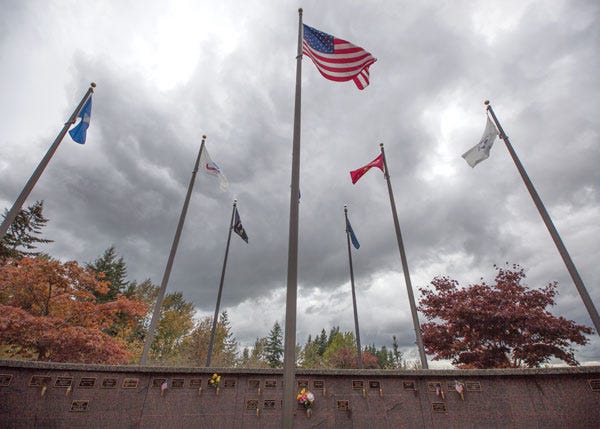Directing Death, Embracing Life
A glimpse into the funeral business
STORY BY DREW CASTELLAW
photos by Annmarie Kent
The funeral director passes out felt-tipped pens as friends and family approach their loved one’s casket to sign their last goodbyes. What was once a clean, bleached-oak surface is now a rainbow-colored whiteboard covered with “I’ll miss you” and “be good buddy.”
Ed Wahl, 74, is reliving one of the most memorable gravesite ceremonies he has experienced. “To me, that was extremely satisfying to watch,” he says.
Wahl has been an embalmer and funeral director in the death care industry for more than 50 years. After high school, his 17-year-old self was fascinated with the mortuary business. At that time, it was a very secretive business, he says. Today, Wahl continues to help people through the grief of loss at Moles Farewell Tributes in Bellingham.
Death care industry workers observe various rituals surrounding death and grief. Often, their perspectives of life and death evolve the more they observe this process.
“It’s the little things, like I won’t hang up the phone with a loved one without saying ‘I love you,’” says Brian Flowers, a funeral director at Greenacres Memorial Park in Ferndale.
In his six-and-a-half years as a funeral director, Flowers has seen a trend in how people manage grief and death.

“[In this country as a whole], we’re afraid of death terribly and we try to deny it and sweep it under the carpet and ignore it and sanitize it,” Flowers says. “We let professionals handle it and we don’t engage in the realities and power and importance that death has.”
One way Flowers helps people confront grief is to empower the families with funeral director jobs they can do themselves, such as closing the casket at the end of the ceremony.
During one ceremony, Flowers let the father use the shovel to bury his son. In the middle of winter, the wind howled and picked up dust from a foot-and-a-half of snow as the family and friends walked in procession carrying the casket by a hand-drawn cart. They approached the gravesite behind a six-foot berm in the meadow as the son was propped up on a custom casket created by his father.
Flowers and other employees lowered the casket into the ground and stepped back as friends and family dropped one thousand paper cranes into the grave. The father began to bury his son, with tears trickling down his face. After digging for 45 minutes, he approached Flowers, shook his hand and said, “Thank you, it’s been a pleasure.”
From initial death to burial,the body goes through a three-step procedure including disinfection, pre-viewing restoration and preservation. As an embalmer and funeral director, Wahl participates in the entire process.
In addition to frequently observing the grieving process, funeral directors also have the challenge of organizing multiple services at once.
An average National Funeral Directors Association (NFDA) member funeral home handles 113 calls per year and has three full-time and four part-time employees, according to the NFDA.
The challenge for Troy Cummings, a park technician at Bayview Cemetery in Bellingham is dealing with other people’s varied ways of grieving and remaining accepting to the differences.
“You really have to be a midldleman, even though in your head you have an opinion of what you believe,” he says.
Cummings, 48, observes ceremonies from all backgrounds, including Muslim, Jewish, Christian, Buddhist and non-religious. The major part of his job is making the park presentable and approachable. He coordinates burials, installs headstones, maintains water lines and digs graves. One of the largest stones he has installed is the “Sitting Angel,” 5-foot tall, 3-foot wide gray headstone that displays a hand-carved angel sitting over the gravesite.
Even though the Bayview Cemetery maintains a 60–40 average ratio of burials to cremations, the cremation rate in the United States continues to rise. In 2012, the cremation rate was 43.2 percent, and is projected to increase to 48.8 percent by 2017, according to the Cremation Association of North America. Flowers views this increase as a transitional period in United States culture.
“We’re in a place in our culture where we’re trying to figure out new rituals,” Flowers says. “It’s fascinating participating in that process and trying to craft those new rituals for families.”
People are tending to cremate remains because it can be more private and can have a do-it-yourself aspect, he says. Spreading the ashes at a favorite location, loading them into shotgun shells, mixing them into tattoos or shooting them into orbit in space are some new rituals people are conducting.
It’s the little things, like I won’t hang up the phone with a loved one without saying ‘I love you’.
Helping others through a difficult period of life by removing the burdens of paperwork and administrative technicalities helps families heal, Flowers says. Workers in the death care industry often view themselves as guides that simplify this emotional time, making it easier for people to process the event and move on.
After many years in the business, Wahl has observed firsthand the evolution of how the general population views the cemetery environment.
“Every morning, there [are] people jogging through the cemetery,” he says. “It’s becoming a park rather than a place to be feared.”
In many cases, the modern-day funeral has become a celebration of life, rather than a time to dwell on death.
